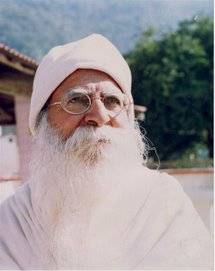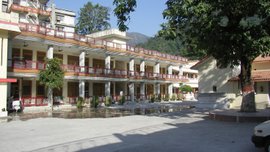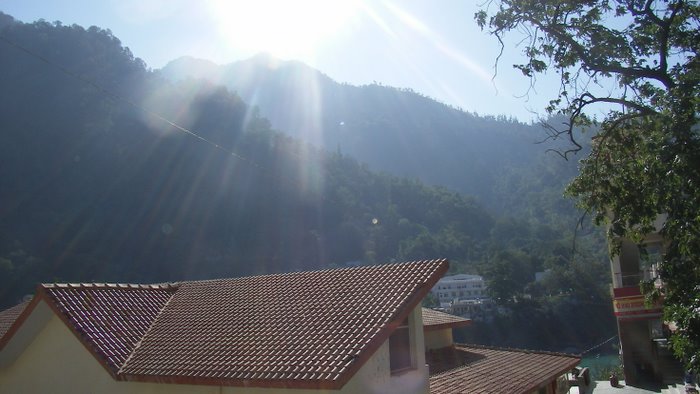In the abode of Yogis
Six months later, his Master appeared to Kulanandji in a vision and recommended that he go and complete his spiritual training in the Himalayas. He obeyed and settled in a cave in Deoprayag on the road to Badrinath, one of the most sacred pilgrimage sites in India.
In those mountains, known to be the country of eminent saints, Kulanandji followed very strict spiritual practice, and in less than three years, reached a very high degree of perfection. One must add to this the fact that he incorporated all the powers of his Master and so became the incarnation of Sacha Baba. That was why Swami Kulanandji was later known as “Sacha Baba”, and has been called by that name ever since. However, in order to distinguish him from his Master Sacha Baba Girnari, we will call him Sacha Baba Kulanandji in all our articles.
Six months later, his Master appeared to Kulanandji in a vision and recommended that he go and complete his spiritual training in the Himalayas. He obeyed and settled in a cave in Deoprayag on the road to Badrinath, one of the most sacred pilgrimage sites in India.
In those mountains, known to be the country of eminent saints, Kulanandji followed very strict spiritual practice, and in less than three years, reached a very high degree of perfection. One must add to this the fact that he incorporated all the powers of his Master and so became the incarnation of Sacha Baba. That was why Swami Kulanandji was later known as “Sacha Baba”, and has been called by that name ever since. However, in order to distinguish him from his Master Sacha Baba Girnari, we will call him Sacha Baba Kulanandji in all our articles.
Sacha Baba Kulanandji leaves the Himalayas
In 1947, Sacha Baba Kulanandji was divinely instructed to carry on the spiritual transformation of the world that his Master had started. He therefore came down from the Himalayas and travelled all over India for seven years to see and understand how people actually lived. He saw how they suffered from so many hardships. He was so touched that as soon as he arrived at Jagannath temple in Puri, which was the end of his journey, from his soul spontaneously sprang a song which he sang:
In 1947, Sacha Baba Kulanandji was divinely instructed to carry on the spiritual transformation of the world that his Master had started. He therefore came down from the Himalayas and travelled all over India for seven years to see and understand how people actually lived. He saw how they suffered from so many hardships. He was so touched that as soon as he arrived at Jagannath temple in Puri, which was the end of his journey, from his soul spontaneously sprang a song which he sang:
Prabhu Aap Jago, Paramatma Jago,
Mere Sarva Jago, Saravatra Jago,
Dukhaantak Khel Kaa Ant Karo.
Sukantak khel prakash karo.
Wake up Blessed One ! Beloved One wake up
Wake up my very own, wake up my all,
Wake up in the whole world, Wake up in every heart,
End this era of pain and sorrow,
Light up the era of joy and bliss.
It was Sacha Baba’s soul invoking God. Then he went to the seaside nearby. There he saw a scene of unbelievable beauty, for Lord Vishnu was there in all His glory, in radiant light which covered the whole world.
The marvellous work promised
In 1953, Sacha Baba Kulanandji founded an ashram in Allahabad called Sacha ashram, near Triveni Sangham, a confluence of three of the most sacred rivers in India: the Ganges, the Yamuna and the mythical Saraswati. Indeed, in a vision, his Master had told him to found an ashram in Allahabad and have the mantra Prabhu Aap Jago chanted there, for, as his Master explained, this song which he had chanted for the first time at the Jagnnath temple in Puri was in fact a very powerful mantra which was to be used for the spiritual awakening of the entire humanity. After the foundation of the ashram, when everything was ready in 1960, the mantra was indeed sung for twelve years straight. This cycle ended in 1972 and was marked by a great religious festival during which one of the most sacred and powerful fire ceremonies, the lakschandi Mahayagna was organized. The aim of this ceremony was to awaken humanity and contribute to bringing peace and harmony in the world during that period of cold war and very dangerous international tension.
An instrument for all
However, the Prabhu Aap Jago mantra is still sung daily in all the ashrams of the Sacha lineage during religious ceremonies and by disciples in their daily sadhana, for it is an excellent means of contributing to the awakening of humanity. All people of goodwill everywhere in the world can use it to participate in this magnificent undertaking. In this way, one can work towards the awakening of all beings as well as one’s own at the same time.
However, the Prabhu Aap Jago mantra is still sung daily in all the ashrams of the Sacha lineage during religious ceremonies and by disciples in their daily sadhana, for it is an excellent means of contributing to the awakening of humanity. All people of goodwill everywhere in the world can use it to participate in this magnificent undertaking. In this way, one can work towards the awakening of all beings as well as one’s own at the same time.
Some aspects of Sacha Baba Kulanandji’s work
The work that Sacha Baba Kulanandji carried out during his whole life was gigantic, and it went from the training of excellent disciples to the raising of the consciousness of humanity through work on the spiritual planes. It is not known either by the general public how much he did to eradicate famine in India. There is an instructive story about this, and we may tell it later on, but for the moment let us get back to his work as a whole. In a way, he also reduced the distance between man and God by special work on the inner planes.
In fact, not only had Sacha Baba been a great avatar in a past life, but was also one in this life, and time will bear witness to the immense work he accomplished. (Continued in Part 7)



No comments:
Post a Comment